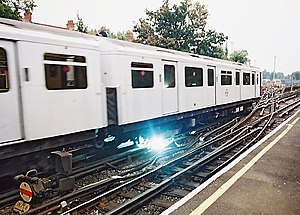| Revision as of 18:18, 15 September 2006 editPickle UK (talk | contribs)11,846 editsm →[]← Previous edit | Revision as of 14:47, 17 September 2006 edit undoHenning Makholm (talk | contribs)Extended confirmed users, Rollbackers7,449 editsm recat: Electric railways -> Electric rail transportNext edit → | ||
| Line 73: | Line 73: | ||
| ==External links== | ==External links== | ||
| ] | ] | ||
| ] | ] | ||
| ] | ] | ||
Revision as of 14:47, 17 September 2006
40% (3,062 miles / 4,928 km) of the British rail network is electrified and 60% of all rail journeys are by electric traction (both by locomotives and Multiple Units).
650 to 850 V DC Third rail

- LWSR / Southern Railway / Southern Region of British Railways - everything but a few freight branches, Marshlink, North Downs Line, Uckfield branch of the Oxted Line and services through Salisbury.
- Northern City Line - ECML to Moorgate - A former main line taken over by the Underground and turned into a tube line. It was however isolated by the abandonment of the 1930s "New Works" programme (and the development of the greenbelt). Tube services were further truncated by the new Victoria Line in 1964 (which shortened the northern end of the line). The remainder was handed over to BR in 1975 in conjunction with electrification of ECML to allow dual voltage (ie both 25Kv AC Overhead and Third Rail DC) commuter trains into London. A link with the ECML was made to enable this. Presumably third rail was chosen as the tunnels were of too narrow a bore to allow overhead lines to be installed (as they are on the Snowhill, Thameslink route.)
- Merseyrail Electrics (Merseyrail)
- Glasgow Subway ?
- Tyneside Electrics - 630V DC(de-electrified by BR in 1960 then turned into Tyne and Wear Metro )
- Docklands Light Railway (bottom contact third rail)
630 V DC Fourth Rail

- London Underground
- LNWR - London suburban network - Euston and Broad Street to Watford Junction, Croxley Green and Richmond ( North London Line and Watford DC Line )
The Watford DC Line between Queens Park and Harrow & Wealdstone is peculiar in that it is used by both Silverlink Metro trains, designed for 750V third rail, and Bakerloo Line trains designed for 630V third and fourth rail. Consequently the voltage is set at a suitable compromise value around 690V nominal, and the centre rail is at the same potential as the return running rail, whereas in normal London Underground usage the traction supply floats with the centre rail at nominally -230V and the outer rail at nominally +420V. giving 630V overall.
1200 V DC Side Contact rail
- Manchester Victoria - Bury and (this system was abandoned when the line was converted to become part of the Manchester Metrolink)
1500 V DC Overhead

- Manchester-Sheffield-Wath line. Known as the Woodhead Route, the line was closed east of Hadfield in 1981 and the remaining section was converted to 25 kV AC in December 1984.
- Shenfield Metro (Great Eastern Main Line) - converted to 25 kV AC, initially with some sections at 6.25 kV
- Tyne and Wear Metro - largely over the "Tyneside electrics" routes which had been electrified using a third rail until the 1960s.
- Newport - Shildon line (closed in the 1930s).
3500 V DC Overhead
6600 V (6.6 kV) AC Overhead @25 Hz
- LBSCR
- Lancaster to Heysham via Morecambe (Morecambe Branch Line)
6250 V (6.25 kV) AC Overhead @50 Hz
- Shenfield Metro (Great Eastern Main Line) - since converted in stages to 25 kV
- Parts of Glasgow Suburban (see SPT and Transport in Glasgow)
During the initial electrification of parts of the network to 25 kV AC overhead the initial solution to the limited clearance problems in suburban areas (due to numerous tunnels and bridges) - notably London and Glasgow - was to use the lower voltage of 6.25 kV AC Overhead. Latter technological improvements allowed these area to be converted to 25 kV AC Overhead.
25000 (25 kV) AC Overhead @50 Hz

- LTS - converted from 6.25 kV AC overhead
- GEML - converted from 6.6K V AC overhead and 1500 V DC overhead
- ECML - in the 1980s
- MML (only to Bedford) - in the 1980s
- WCML - in the 1950s under the 1955 BR modernisation plan to Birmingham (new Street) / Liverpool (Lime Street) / Crewe / Manchester (Piccadilly). Extended in the 1970s to Glasgow. The branch to St Albans was electrified by Network South East 1987-88. In 2003 Crewe to Kidsgrove section of the Crewe to Derby Line was electrified as a diversionary route for the WCML.
- Glasgow Suburban (see SPT and Transport in Glasgow) - started in the 1950s under the 1955 BR modernisation plan.
- Leeds to Skipton (Airedale Line) / Leeds to Bradford ( Wharfedale Line )
- Manchester to Glossop / Hadfield (converted from the truncated 1,500V DC Manchester-Sheffield-Wath electric railway ) and the Manchester Airport Line (although prmiarly used by Diesals)
- Birmingham Cross-City Line
- GWML (only to Heathrow - see Heathrow Express and Heathrow Connect)
- CTRL - employing auto-transformers
- Crossrail (Proposed)
See also
- Railway electrification system
- Railroad electrification in the United States
- List of current systems for electric rail traction